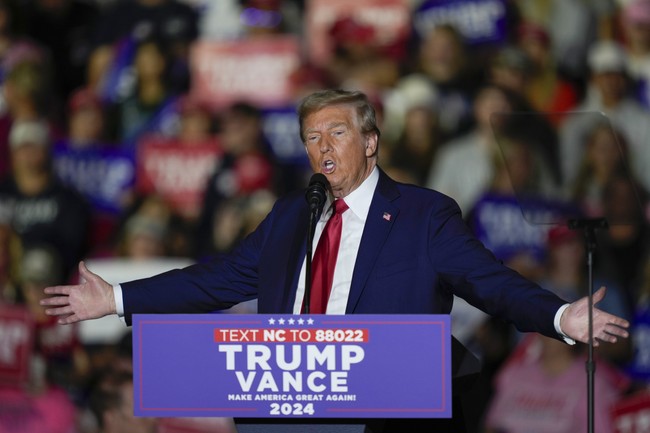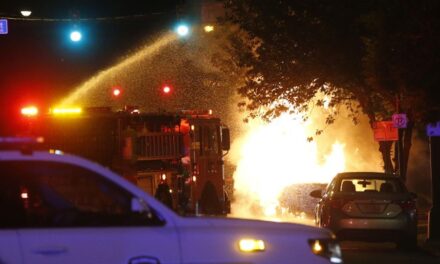We support our Publishers and Content Creators. You can view this story on their website by CLICKING HERE.

It’s hard to believe that we’re just a few hours away from it officially being Election Day, but yes, we’ve finally made it to that point.
In North Carolina, there has been a distinct buzz in the air on the Republican/conservative side since early voting started on October 17th, with GOP presidential nominee Donald Trump’s push for Republicans to take advantage of early voting spurring early vote numbers for the party not seen in previous election cycles.
Advertisement
The difference was pronounced enough that it caused a full-blown panic for the Harris-Walz campaign, which was aware from past elections that early voting has typically been the strong suit for Democrats, not Republicans. Further, there has been much angst on the Democrat side of the aisle regarding the black vote in North Carolina, which lagged but made up some ground in the closing days of early voting.
READ MORE: The ‘Warning Sign’ in North Carolina That Is Giving Kamala Harris Nightmares
North Carolina had 17 days of early voting, which ended Saturday. Here are some demographic data points to munch on from the in-person early voting numbers:
3/6
Unaffiliated voters submitted the most ballots, followed by Republicans. Democrats are well behind where they were at the same point in 2020. #ncpolChange in turnout from 2020 to 2024:
D: -266,200
R: +31,448
U: +110,109 pic.twitter.com/hnbCu8uJM0— Andy Jackson (@andyinrok) November 4, 2024
4/6
The 2024 electorate is much older than in 2020. Here is the difference for younger and older voters. #ncpol
18-35: -77k (-1.1%)
65+: +133k (+3.8%)
It is also whiter than 2020.
White: +52k (+3.0%)
Black: -101k (-1.7%)
Undesignated: -106k (-2.1%) pic.twitter.com/ZhjF1LRBRs— Andy Jackson (@andyinrok) November 3, 2024
Presidential race
Here’s more info/analysis from Jim Blaine, an avid numbers cruncher and former chief of staff for State Senate Leader Phil Berger (R):
Advertisement
▶️UNAs overtook REPs on final day to ‘win’ EV
▶️Story of EV is DEMS missing ~270K voters from 20
▶️GOP leads DEMs by ~40K in EV
▶️Comparing 24 EV to 20 EV, GOP has net ~300K advantage over DEMs (GOP up ~30K from 20 + Dems down ~270K from 20)
▶️Breaking with historic EV pattern of DEM dominance dating back to 2008, our models indicate Trump will be tied or have a very slightly lead in combined mail and in person EV
▶️GOP has between 30K and 60K more Election Day and high propensity voters who have not voted than Dems
▶️Dems have between 60K and 100K more low propensity voters who have not voted than GOP
▶️Black turnout is down in raw vote and share of EV
▶️Dems must turnout low propensity voters on Election Day to give Harris a chance to win NC
Donald Trump, JD Vance, and their surrogates have spent a lot of time in key counties, both before and during early voting, which no doubt has contributed to the surge in EV numbers for Republicans.
This is where former President Trump is rallying today — swing county within battleground North Carolina (also the home county of Gov. Cooper) — Nash County voted for the presidential winner the last 3 elections all by less than 500 votes #ncpol #Election2024 #Vote @ABC11_WTVD pic.twitter.com/l0zgUsqRFS
— Tom George (@TheTomGeorge) October 30, 2024
Of course, a lot of data we’ve been seeing from the various states including North Carolina has been crunched with the thought in mind that most if not all of those in the D and R camps will stick with their respective political parties at the ballot box.
Advertisement
But one thing people should keep in mind is that there is still a segment of registered Democrats in the South who vote for Republicans. While it’s unclear exactly how many might have voted for the Trump-Vance ticket in North Carolina, if the Democrat turnout in early voting wasn’t where Dems wanted/needed it to be, losing just a few thousand Democrat votes on Election Day to Republican candidates potentially could spell disaster.
On a related note, as veteran Democrat political consultant Thomas Mills explained, unaffiliated voters overall, “are older with almost half over 55 years old, meaning they probably lean pretty heavily Republican.” For the record, at this point, there is essentially a three-way tie as far as voter registration goes:
As to party registration compared to final 2020 party %s:
We have a new leader: NC Unaffiliated Voters as a overall percentage of all early votes.
To have basically a three-way tie is unprecedented in NC early voting patterns.#ncpol #Election2024 pic.twitter.com/gWEDcKLW5H
— Dr. Michael Bitzer (@BowTiePolitics) November 3, 2024
First Congressional District Race
The other race to pay attention to in North Carolina that has big national implications is the First Congressional District race (located in eastern NC), which I wrote about in detail earlier. This is the lone House race in the state that is considered a “toss-up” thanks in part to recent redistricting.
Advertisement
The nominees are first-term Rep. Don Davis (D) and retired Army Colonel Laurie Buckhout (R). While some of the demographics of the district have changed due to redistricting, it still has a large black population, which Democrats are counting on to bring the district home again for Davis. Buckhout, meanwhile, has been endorsed by Trump and seeks to turn red a seat that has been blue since 1883.
But Democrats have to be concerned considering of all the Congressional races, the two that had the lowest turnout were District 12 and District 1:
2/2
The congressional districts with the highest turnout are the 4th (Triangle) and the 11th (mountains). The two with the lowest are the 12th (Charlotte) and the 1st (northeast). #ncpolI will have a fuller data report on the Locke homepage later today.https://t.co/lbXJVE9UN9 pic.twitter.com/Ym21AX5aLp
— Andy Jackson (@andyinrok) November 4, 2024
Further, a reliable GOP source pointed out to me that the “2024 Electorate compared to 2020 for the new First Congressional District is 10 percent less Democrat, five percent more Republican (that’s a 15 percent swing), five percent more Unaffiliated, and six percent less Black voters through early voting.”
If they can’t make up some ground on Election Day, Democrats may lose that seat and, possibly, any chances of winning back control of the House along with it.
Relatedly, what we see happen in that district could be a bellwether for how the state goes in the presidential election, as data analyst Kyle Kondik noted in a “races to watch” opinion piece for the New York Times:
Advertisement
A Davis loss would be a blow to Democratic hopes of winning a majority and would be consistent with Trump winning North Carolina, while a Davis victory — particularly if the margin is not that tight — may suggest Democratic troubles with Black voters were overstated.
As the old saying goes, though, it ain’t over ’til it’s over (no matter how many fake narratives the MSM wants to push). Meanwhile, if you haven’t already, go do your thing and vote!

 Conservative
Conservative  Search
Search Trending
Trending Current News
Current News 





